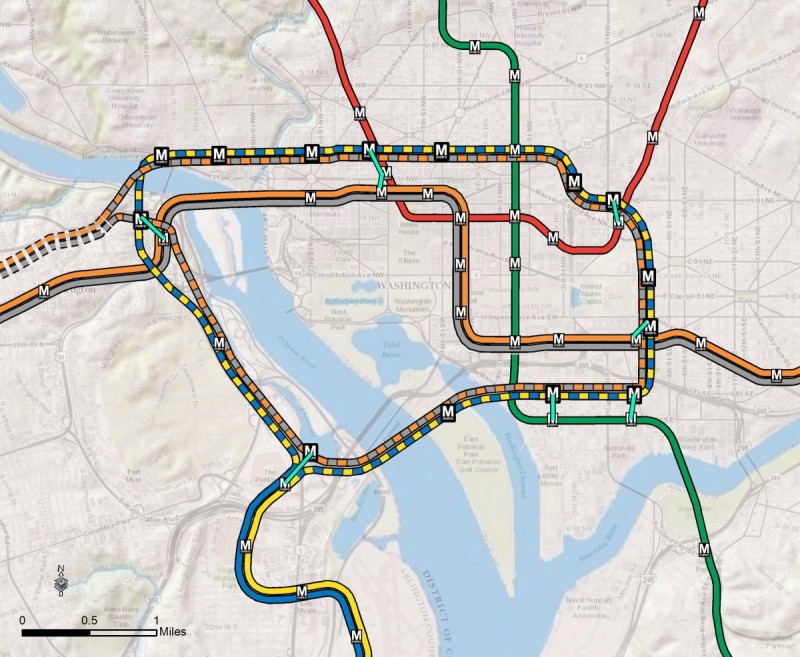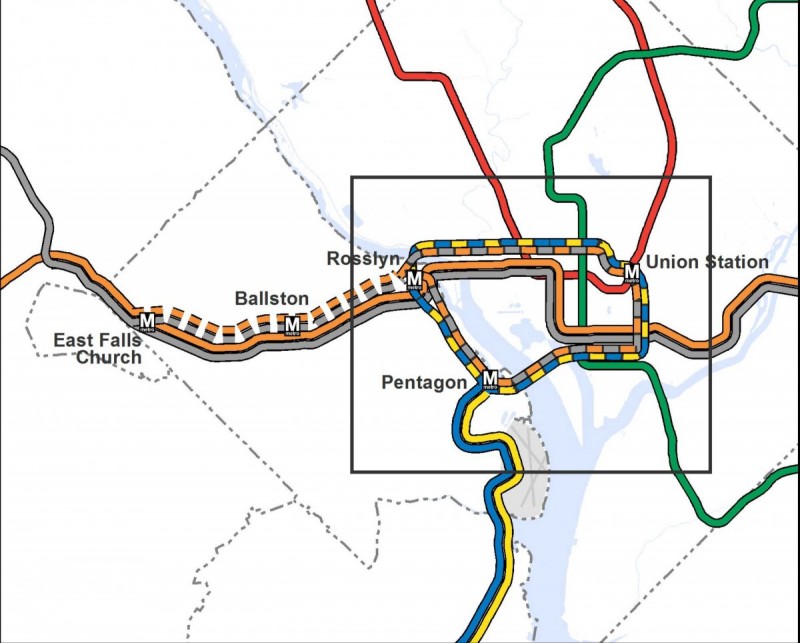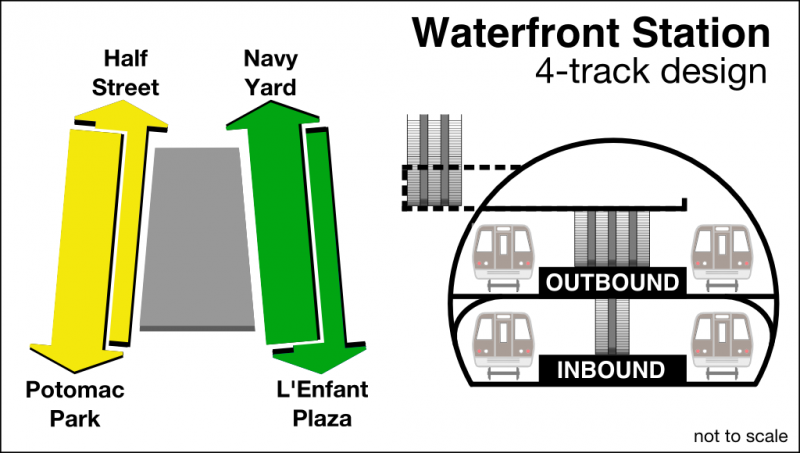Metro might one day build an Arlington-DC “loop.” What’s that again?

Image by WMATA.
WMATA will ask Northern Virginia to study adding a second station for the Blue Line at Rosslyn. A regional task force recommended five long-term transportation initiatives, including a Metro loop in Arlington and central DC.
We haven't heard much about these ideas for a few years. Most of the attention (rightly so) around Metro has gone to its safety, maintenance, and funding woes. No new Rosslyn station or Metro loop is around the corner (curve?), but it's interesting that officials are talking about them once more.
So what are these ideas?
They all stem from a fundamental inefficiency in Metro's initial design: Lines share tracks in the core and branch out to the edges. That means stations in the branched area will see about half as much service as in the core. Places like the Rosslyn-Ballston corridor and south Arlington/Alexandria are big job centers in their own right (not to mention Tysons), and branched levels of service aren't necessarily right.
In particular, the Blue Line combines with the Yellow Line in Alexandria and south Arlington, then switches to share tracks with the Orange Line. Thus, one Blue Line train takes away space from both Yellow and Orange. Now that Metro has the Silver Line, there's even more competition for space in the Rosslyn to Stadium-Armory tunnel. A station on any of the three lines west/south of Rosslyn might see only one-third to two-thirds the service of the combined part.
This was a problem even before the Silver Line opened, and Matt Johnson wrote all about it in a few series of posts in 2013, along with some amazing graphics. Here's a summary of the issues and ideas.
Metro's stuffed full at Rosslyn. What can be done?
Matt illustrated the challenges with the Orange, Silver, and Blue merge with some clever maps that depict Metro service “filling up” empty lines, like pipes. He showed how Metro was trying to alleviate the pressure with a change called “Rush Plus,” which meant fewer Blue Line trains and more Orange and Yellow trains.
That turned out to create crowding problems and long waits on the Blue Line, and Metro ended Rush Plus in 2017.
Matt looked at the two immediate solutions being considered: a “wye” so that trains from Ballston could turn south toward Arlington Cemetery, and a second Rosslyn station. WMATA ultimately picked the second Rosslyn station option.
Metro beyond 2025: The Blue Line to Georgetown
Building a second Rosslyn station will help untangle the trains and allow more service on Northern Virginia's outer line segments, but if the train just stops at Rosslyn, any riders going to DC will then need to transfer to a Silver or Orange train. And unfortunately, that'll likely require a one-block walk.
That's why a second Rosslyn station is really just a precursor to some kind of new tunnel under the Potomac to Georgetown and then over to Union Station.
Rosslyn also isn't the only choke point, and the Blue Line isn't the only one that shares two separate track segments. The Yellow Line shares tracks with the Blue Line down south, but then combines with Green in DC. This limits Green Line service and means longer waits for people from Shaw to Greenbelt in the north and Waterfront to Branch Avenue in the south.
The areas around Waterfront and Navy Yard stations, and U Street to Petworth, are some of DC's fastest-growing, not to mention the baseball stadium. One line which can't run as frequently as the Red Line isn't ideal. That's why another idea is to separate out the Yellow Line from the Green.
Matt also thought about possible service patterns with a wye or even three wyes, though these aren't under consideration any more.
How might the new Metro loop work?
Matt wrote the “stuffed full” series in January of 2013. That December, WMATA wrapped up a multi-year study on this issue with a recommendation to build a “loop line” between Rosslyn, Union Station, and Pentagon.
Image by WMATA.
Really, it's actually two “lassos,” where some trains from the Orange and Silver branches run around the loop and head back west, while some other trains from the Yellow and Blue branches run around it and go back south. The proposal also included an express line along I-66 between East Falls Church and Rosslyn.
Image by WMATA.
Matt pondered some of the possible service patterns on these lines. Do Orange/Silver trains all go around the loop in one direction and Yellow/Blue trains all the other? Or what?
Three ways Metro's loop proposal could get better
Matt rounded out his series with some suggestions for the loop. Biggest among them were suggestions to locate the stations where people wouldn't have to walk far to transfer.
For instance, while none of the design is done, initial statements about the loop said it might go under I Street SW/SE, one block from the existing subway under M Street.
Unfortunately, people riding in on the Yellow Line, which would be heading toward the Capitol and Union Station, may often want to transfer to a Green Line train headed downtown. If the stations are a block away, that's a considerable walk. While it'd be more expensive, could the Waterfront station be rebuilt as a four-track station, ideally where people can just transfer across the platform?
What's actually happening?
Nothing's about to happen with these ideas. But big transportation projects percolate for decades before getting funded.
For now, WMATA is asking Northern Virginia to put $2 million toward more detailed studies for the second Rosslyn station. Meanwhile, the regional Transportation Planning Board will vote on December 20 for long-term transportation projects it wants to focus on.
The preliminary list includes “transitways” like light rail and (mostly) Bus Rapid Transit around the region, more HOT lanes which are free for carpools and tolled for solo drivers, and Transportation Demand Management (where employers help employees find out about ways to get to work without solo driving).
The highest-scoring option, which isn't transportation at all but simply growing more in the places with existing transportation infrastructure, is one of the five. So is “Metro core capacity,” which for the study's modeling meant this loop along with eight-car trains, improvements to busy stations, and better bicycle and pedestrian access to stations.
If the TPB approves including this in the plan, still nothing will happen immediately, but the region will keep talking about it. By the 2020s or 2030s, maybe we'll be able to actually start building something. Talking about it, and then funding more detailed cost and feasibility studies, has to be a first step.





